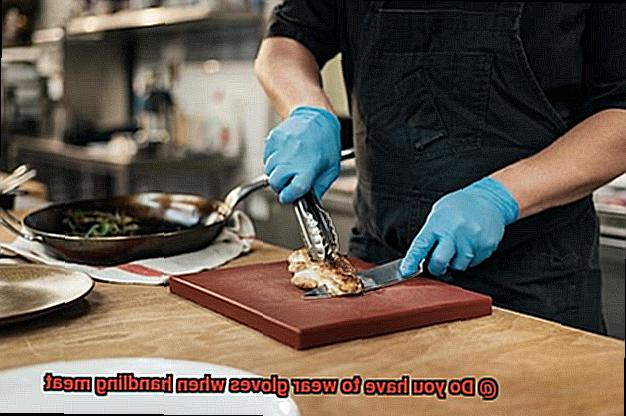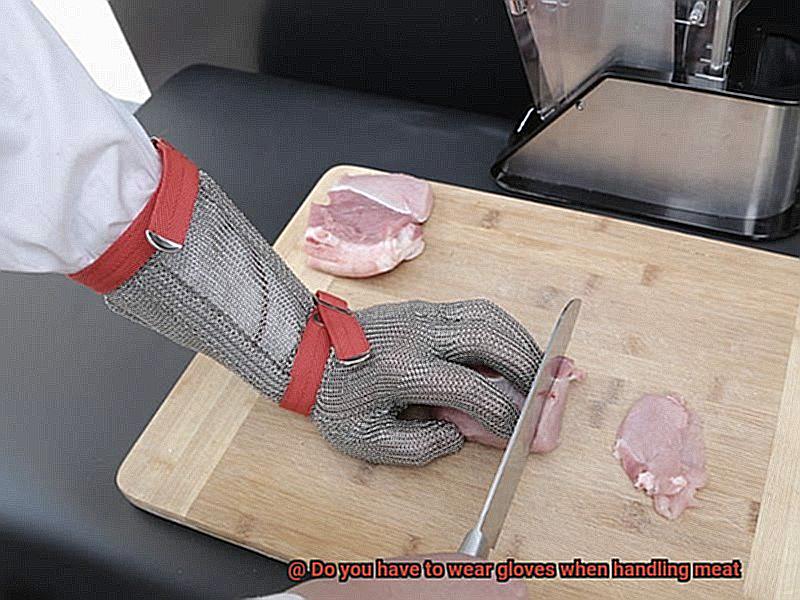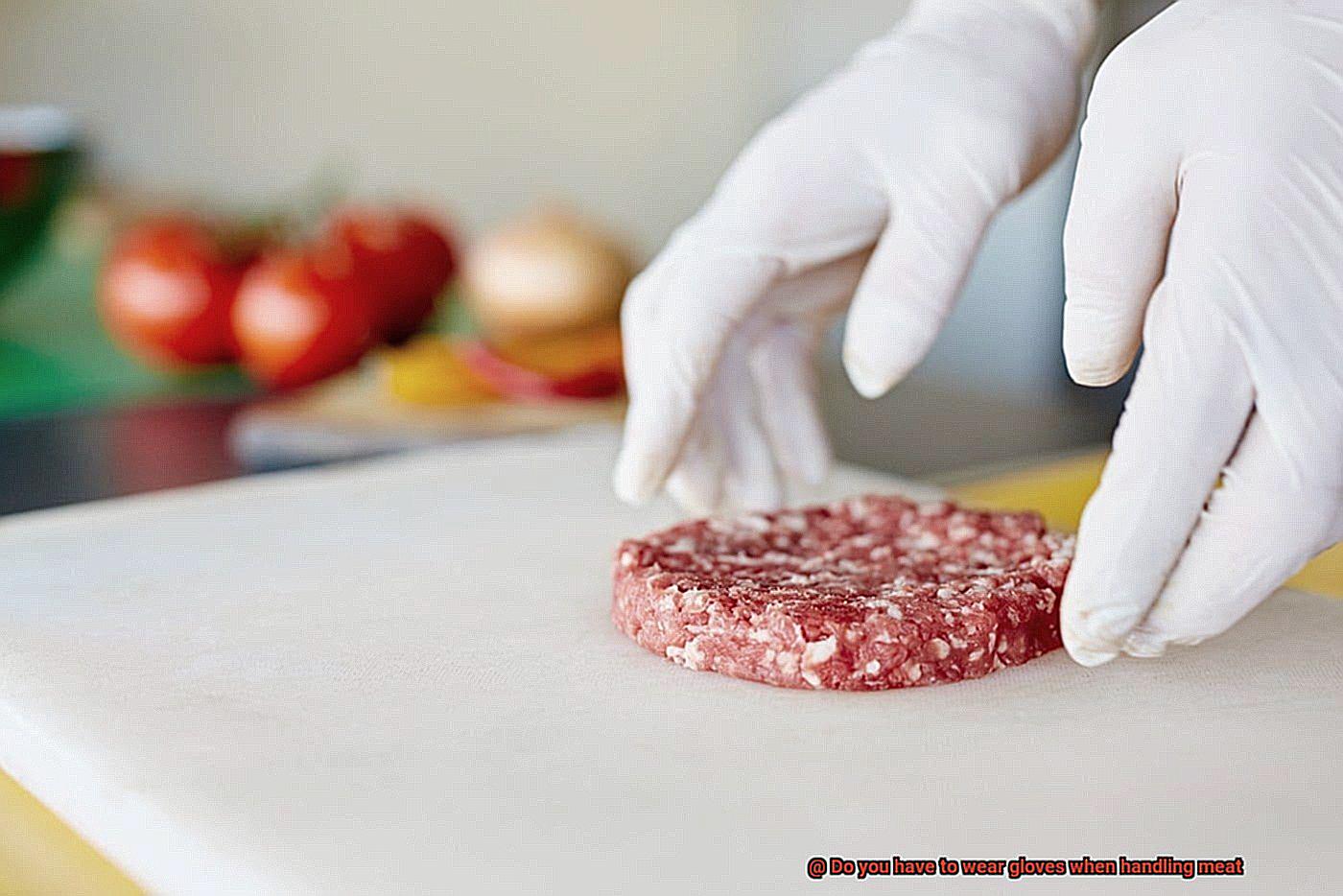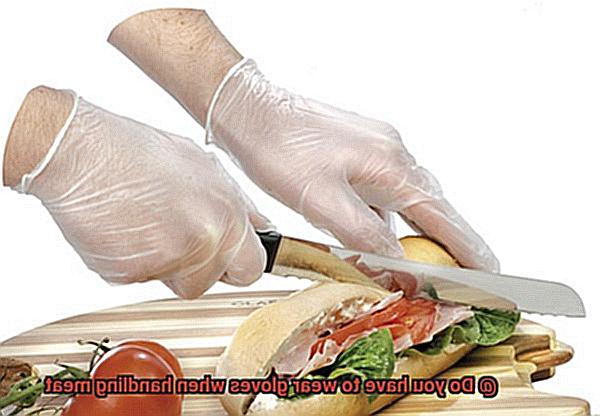Are you a meat enthusiast or someone who frequently cooks for others? Then you’re probably well aware of the potential food safety hazards that come with handling raw meat. It’s no secret that handling raw meat requires utmost care and attention to avoid unwanted bacterial infections. So, the question arises – do you have to wear gloves when handling meat?
The debate about whether gloves are necessary when handling meat is ongoing. Some argue that gloves provide an extra layer of protection, while others say that they don’t prevent the spread of bacteria and may even create a false sense of security.
In this blog post, we’ll delve into whether wearing gloves is really necessary when handling meat and why. We’ll discuss the risks associated with handling raw meat, what gloves actually do, and whether they’re worth wearing. Whether you’re a seasoned chef or a home cook, read on to find out if wearing gloves is essential when dealing with meat and what precautions you can take in the kitchen to ensure your safety.
Contents
What is the USDA Rule Regarding Gloves and Meat Handling?
When it comes to handling meat, food safety is of utmost importance. The United States Department of Agriculture (USDA) has set stringent guidelines for meat handling and processing, including the use of gloves. While gloves are not always required, proper handwashing procedures must always be followed to prevent contamination.
If you choose to wear gloves when handling meat, they must be made of an impermeable material such as nitrile or latex. Gloves should also be changed frequently to ensure proper sanitation. It’s important to note that gloves do not replace proper handwashing and hygiene practices. Gloves can become contaminated with bacteria and other pathogens just like bare hands. Therefore, it is crucial to change gloves frequently and wash hands thoroughly before and after glove use.
There are situations where wearing gloves is necessary, such as when working with raw poultry or other high-risk meats. Additionally, if you have any cuts or wounds on your hands, wearing gloves can prevent the spread of bacteria.
It’s essential to follow all USDA guidelines for meat handling and processing to prevent the spread of harmful pathogens. In addition, individual states may have their own regulations regarding meat handling and the use of gloves. Meat handlers must be aware of these regulations and comply with them to ensure food safety.
To summarize:
- Proper handwashing procedures should always be followed to prevent contamination.
- Gloves should be made of an impermeable material such as nitrile or latex and changed frequently.
- Gloves do not replace proper handwashing and hygiene practices.
- Gloves are necessary when handling high-risk meats or when there are cuts or wounds on your hands.
- Follow all USDA guidelines for meat handling and processing.
- Be aware of individual state regulations regarding meat handling and the use of gloves.

Why Might You Need to Wear Gloves When Handling Meat?
That’s why gloves are a must-have accessory for chefs and food handlers. But why is it so important to wear gloves when handling meat? Let’s explore the reasons.
Firstly, raw meat is a breeding ground for harmful bacteria like E. coli and Salmonella. By wearing gloves, you can prevent cross-contamination of these bacteria from the meat to other surfaces, utensils, or even other foods. This simple act can significantly reduce the risk of foodborne illnesses.

But that’s not all. Some people may have cuts or open wounds on their hands, which could increase the risk of infection if they come into contact with raw meat. Wearing gloves can help protect against this risk and keep everyone safe.
Moreover, gloves provide an extra layer of protection against potential injuries when handling meat. Large cuts of meat and sharp knives can cause serious harm to bare hands. Gloves can offer an extra layer of protection against cuts or punctures.
When it comes to handling raw meat, wearing gloves isn’t always legally required, but it is considered a best practice. By taking precautions to prevent cross-contamination and protect your hands from potential injuries, you can ensure that your food is safe and healthy for consumption.
Are There Different Types of Gloves for Food Handling?
When it comes to handling food, maintaining proper hygiene is essential to prevent contamination and the spread of harmful bacteria. Wearing gloves is one of the most effective ways to ensure that your hands do not come into direct contact with the food. However, not all gloves are suitable for food handling purposes. Let’s explore the different types of gloves and their benefits and drawbacks.
Latex Gloves:
Latex gloves are a popular choice for food handlers as they are flexible and offer a high level of sensitivity, making them ideal for tasks that require fine motor skills. However, those with latex allergies should avoid using these gloves as they can cause allergic reactions. Additionally, latex gloves can break easily when exposed to certain chemicals or oils, making them less suitable for heavy-duty tasks.
Vinyl Gloves:
Vinyl gloves are another option for food handlers, but they are not as durable as latex gloves and may tear easily. They are also less flexible and can be uncomfortable to wear for extended periods. However, vinyl gloves are an affordable option and provide a good barrier against bacteria.
Nitrile Gloves:
Nitrile gloves are an excellent alternative to latex gloves for those with latex allergies. They offer excellent puncture resistance and durability, making them suitable for heavy-duty tasks. Additionally, they provide a good barrier against bacteria and are more resistant to punctures and tears than latex or vinyl gloves.
Polyethylene Gloves:
Polyethylene gloves are the most affordable option for food handling purposes. However, they offer the least amount of protection and are more prone to tearing than other types of gloves. They are suitable for simple tasks such as handling dry ingredients or non-greasy foods.
In addition to choosing the right type of glove, it is important to ensure that the gloves used are food-grade and meet the necessary safety standards. Gloves should be changed regularly, especially when switching between tasks or handling different types of food.
How to Properly Put On and Take Off Disposable Gloves
Properly Putting On and Taking Off Disposable Gloves When Handling Meat: A Guide to Maximum Hygiene
When handling meat, it is crucial to prioritize hygiene and safety to avoid any potential health risks. One of the most effective ways to do this is by wearing disposable gloves. However, simply wearing gloves is not enough
it is equally important to know how to put them on and take them off properly to prevent cross-contamination. Here’s what you need to know:
Begin with clean, dry hands.
Before putting on gloves, wash your hands thoroughly with soap and water. This helps remove any dirt or bacteria that may be present on your hands.
Choose the right size and quality gloves.
Select a pair of disposable gloves that fit your hands well and are free from any tears or holes. Gloves that are too tight or too loose can hinder movement and increase the risk of tearing.
Putting on the gloves.
Hold the cuff of one glove and slide your hand into it. Use your fingers to adjust the glove and ensure that it fits snugly around your fingers and wrist. Repeat the process for the other hand.

Removing the gloves.
When taking off the gloves, grasp the outside of one glove at the wrist level and peel it off, turning it inside out as you do so. Hold the removed glove in your other gloved hand. Then, slide your fingers underneath the cuff of the remaining glove and peel it off, turning it inside out as well. Dispose of both gloves in a suitable waste bin.
Change gloves frequently.
It is essential to change gloves frequently when handling different types of meat or if they become contaminated during use. This helps prevent cross-contamination between different types of meat.

Wash your hands thoroughly after removing gloves.
After removing gloves, wash your hands thoroughly with soap and water to ensure proper hygiene.
What Are the Benefits of Wearing Gloves When Handling Meat?
If so, you know how important it is to handle meat safely and hygienically. One of the best ways to ensure this is by wearing gloves when handling raw meat.
The benefits of wearing gloves when handling meat are numerous and essential for ensuring food safety and personal protection. Let’s take a closer look at why wearing gloves is so crucial.
First and foremost, gloves act as a barrier between your hands and the meat, preventing any potential cross-contamination. Cross-contamination can occur when harmful bacteria from one surface, such as raw meat, comes into contact with another surface, such as cooked or ready-to-eat food. This can lead to foodborne illnesses and even hospitalization in severe cases. Wearing gloves eliminates this risk and ensures that the meat remains safe for consumption.
Moreover, wearing gloves also protects your hands from any potential injuries while handling sharp knives or other tools. Handling meat can be a messy process, and the use of gloves provides an extra layer of protection against cuts and scrapes. This is especially important if you’re new to cooking or if you’re working with particularly large cuts of meat.
In addition to the safety benefits, wearing gloves can also make the meat handling process more efficient. Gloves provide a better grip on the meat and allow for easier handling and maneuvering. This is especially useful when working with larger cuts of meat or when trying to achieve precise cuts.
What Are the Drawbacks of Wearing Gloves When Handling Meat?
It’s crucial to keep in mind that there are potential drawbacks to wearing gloves while handling meat.
Firstly, wearing gloves may lead to a false sense of security and carelessness when it comes to proper handling techniques. It’s important not to neglect frequent hand washing and thorough meat inspection practices.
Secondly, gloves can easily tear or puncture, especially if they’re of low quality or have been worn for an extended period. If this happens while handling meat, it can increase the risk of contamination and spread harmful pathogens onto the meat.
Thirdly, gloves can interfere with proper handling techniques and utensil usage. This can increase the risk of injuries and improper cooking techniques, which can be hazardous for both the cook and anyone consuming the meat.
Lastly, wearing gloves can cause discomfort and irritation, particularly if they’re made from synthetic materials. This discomfort can lead to distractions and potentially compromise food safety practices.
Should I Wear Latex or Nitrile Gloves for Food Preparation?
The answer is simple – it depends on several factors.
First and foremost, cost plays a significant role. Latex gloves are the least expensive option, but they may trigger allergic reactions in some individuals. Conversely, nitrile gloves are pricier than latex gloves but are an excellent alternative for those with latex allergies.
Comfort is another essential factor to consider. Latex gloves are stretchy and comfortable but can be more prone to tears and punctures. On the other hand, nitrile gloves are known for their durability and resistance to chemicals and punctures, making them perfect for those who need a robust glove.
Potential allergies should also be taken into account. If you or any of your team members have a latex allergy, nitrile gloves are the best option as they are latex-free and won’t cause any allergic reactions.
It’s essential to ensure that the gloves you choose meet safety standards and are approved for food handling. Look for FDA-approved gloves that meet ANSI standards to ensure that they comply with safety regulations.
In summary, when choosing between latex and nitrile gloves for food preparation, it’s crucial to weigh the cost, comfort, potential allergies, and safety standards. Ultimately, the choice depends on personal preference and individual needs. However, keep in mind that wearing gloves is not a substitute for proper handwashing and safe food handling practices.
To help you choose between latex and nitrile gloves easily, here’s a quick checklist:
Latex Gloves:
- Least expensive
- Stretchable and comfortable
- Prone to tears and punctures
- Potential for allergic reactions
- FDA-approved
How to Properly Clean and Dispose of Used Disposable Gloves
When it comes to handling raw meat, proper hygiene is crucial to avoid contamination and foodborne illnesses. Wearing disposable gloves is one way to maintain hygiene, but it’s also essential to know how to clean and dispose of them properly to prevent cross-contamination.
Step 1: Remove Gloves with Care
Carefully remove the gloves without touching the outside surface. Grasp the cuff of one glove and pull it off, then ball up the removed glove in your hand. Use the balled-up glove to grasp the cuff of the remaining glove and pull it off without touching the outside.
Step 2: Dispose of Gloves in a Safe Manner
After removing the gloves, dispose of them appropriately. Don’t throw them in regular trash bins as they can contaminate other items. Instead, use a designated medical waste container or a sealed plastic bag.
Step 3: Wash Your Hands Thoroughly
After disposing of the gloves, wash your hands with soap and warm water for at least 20 seconds. This removes any potential bacteria or germs that may have been on the gloves.
Step 4: Don’t Reuse Gloves
Never reuse or wash disposable gloves as it can damage them and increase the risk of contamination. Always use a new pair of gloves for each task and dispose of them properly after each use.
Step 5: Practice Good Hand Hygiene
In situations where gloves are not available or practical, frequently wash your hands with soap and warm water when handling raw meat. Avoid touching other items or surfaces before washing your hands.
Conclusion
In conclusion, handling raw meat requires strict adherence to hygiene and safety practices to prevent the spread of harmful bacteria and foodborne illnesses. While gloves may not always be legally required, they are considered a best practice in the food industry. The USDA has set rigorous guidelines for meat handling and processing, which include using gloves made of impermeable materials like nitrile or latex.
Gloves act as an additional layer of protection against potential injuries and cross-contamination when dealing with high-risk meats or when there are cuts or wounds on your hands. However, it’s important to note that gloves do not replace proper handwashing and hygiene practices.
There are various types of gloves available for food handling purposes such as latex, vinyl, nitrile, and polyethylene gloves. It’s crucial to choose the right type of glove that meets safety standards and fits well.
Properly putting on and removing disposable gloves is critical to avoid cross-contamination. Gloves should be changed frequently when handling different types of meat or if they become contaminated during use.
To summarize, wearing gloves while handling raw meat is a best practice that can significantly reduce the risk of foodborne illnesses. By following USDA guidelines for meat handling and processing along with individual state regulations regarding meat handling and the use of gloves, we can ensure food safety in our kitchens.






